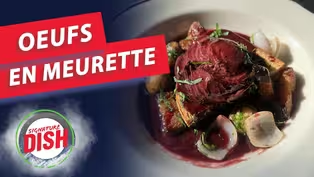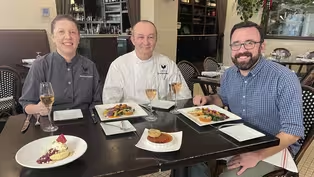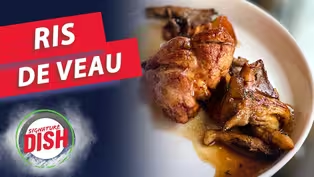Signature Dish
How Bastille Cooks a Moulard Duck Breast
Clip: Season 2 Episode 7 | 6m 22sVideo has Closed Captions
The moulard duck breast at Bastille in Alexandria, VA.
Seth Tillman visits Bastille, a French restaurant in Alexandria, VA, where chefs Christophe and Michelle Poteaux demonstrate how to prepare magret de canard, the moulard duck breast.
Problems playing video? | Closed Captioning Feedback
Problems playing video? | Closed Captioning Feedback
Signature Dish is a local public television program presented by WETA
Signature Dish
How Bastille Cooks a Moulard Duck Breast
Clip: Season 2 Episode 7 | 6m 22sVideo has Closed Captions
Seth Tillman visits Bastille, a French restaurant in Alexandria, VA, where chefs Christophe and Michelle Poteaux demonstrate how to prepare magret de canard, the moulard duck breast.
Problems playing video? | Closed Captioning Feedback
How to Watch Signature Dish
Signature Dish is available to stream on pbs.org and the free PBS App, available on iPhone, Apple TV, Android TV, Android smartphones, Amazon Fire TV, Amazon Fire Tablet, Roku, Samsung Smart TV, and Vizio.
Providing Support for PBS.org
Learn Moreabout PBS online sponsorshipCHRISTOPHE: We're making the magret de canard.
SETH: Magret de canard.
All right.
Well French is not my forte.
What does that mean?
CHRISTOPHE: So, the magret de canard is the name for the moulard duck rice.
It's a fully-grown duck.
Most of the ducks you see for roasting are young duck.
MICHELLE: What we love about the moulard duck is that it has this meatiness, this very delicate gaminess.
If you're a chicken person, you may not like moulard, but if you like beef, you'll love moulard.
CHRISTOPHE: I'm going to first trim it, going to separate the two parts.
So we're going to contour it a little bit.
There's a little bit of silver skin.
We want to remove this.
SETH: Not a lot of marbling through, in this meat at all.
CHRISTOPHE: No.
The moulard is actually very lean, pretty much the entire part of the fat is on the skin.
Now we're going to score it.
What it's going to allow is that when we put it on the pan, the fat can escape, so I'll do the same for the other one.
MICHELLE: Once we've scored the duck, we're going to season generously, shall we say, salt, pepper.
And we're going to place it in a sous vide bag.
CHRISTOPHE: We cook a sous vide to help seal the flavor and it helps tenderize the meat.
MICHELLE: So, I'm gonna add the garlic.
I'm gonna add thyme, rosemary, and bay leaf, and then I'm gonna give it a generous squirt of olive oil.
SETH: How long is this going to go in the sous vide for?
CHRISTOPHE: 45 minutes.
SETH: Oh, okay.
So not very long.
MICHELLE: At what temperature?
CHRISTOPHE: At 52 degrees Celsius, which is about 124... SETH: Celsius?
CHRISTOPHE: Yes.
MICHELLE: Oh, yes!
CHRISTOPHE: We use metric, sorry.
MICHELLE: So, this is what it looks like after we've cooked it, we've chilled it, and now it's ready to be prepared.
So Seth, while Christophe shows you how to sear off the duck, I'm going to go make dessert so we can enjoy it after.
SETH: That sounds wonderful.
CHRISTOPHE: All right, Seth, why don't you follow me?
SETH: Let's do it.
CHRISTOPHE: Seth, that's where we're going to sear the duck.
SETH: All right.
What's the secret to uh, to cooking the moulard?
CHRISTOPHE: The secret is to have a pan that is hot, not blasting hot.
So I would say a medium-high to get the skin to start developing a crust.
So, putting skin side down, you can hear the sizzle right away.
SETH: And no oil or anything needs to go there.
CHRISTOPHE: No oil's necessary.
There's so much fat.
SETH: It's like cooking with bacon or something.
CHRISTOPHE: Exactly.
It's not going to taste the same though.
SETH: Also delicious though.
CHRISTOPHE: Also delicious.
We're not discriminating.
As it renders fat, it's important to remove the fat.
Otherwise, what you end up doing is deep-frying your duck breast.
SETH: So you're looking for more of just a sear?
CHRISTOPHE: Yes.
We're going to start removing some of the fat.
Take the pan, hold the breast and drop it into your container.
SETH: It's amazing how much fat's already rendered out.
CHRISTOPHE: It's only the beginning.
You see it start, you get a little bit of color and you can smell it so you know it's going to be good.
I mean, come on, it's fat.
So, here we're going to get rid of a little bit of the fat again.
So, that fat is not what you're eating.
So when people say, "Oh, duck is so fatty, it's so rich."
Oh, you're not cooking it right.
SETH: But the fat that is in there, especially when you flip it, it's going to help us flavor the other side.
CHRISTOPHE: Yes, yes, yes, absolutely.
On this side, we can see the edges here a little bit darker.
SETH: If I walked right into this kitchen, I would just assume you're cooking up a rib-eye steak right there.
CHRISTOPHE: It is a red meat.
It is a red meat.
So it's starting to get some nice color, and this little darker spot here.
So now we're going to flip it and seal the flavor in the meat.
So I'm searing all the different sides, make sure it gets a good sear on every side.
So now we're going to let it rest and then we'll slice it and plate it.
So once it rested enough, we'll slice it up.
We are going to serve it with little braised kale, some baby carrots, and small baby onions, a sweet potato souffle.
And we have a cranberry orange gastrique.
We'll spoon the orange cranberry gastrique over the duck.
Garnish with a few candied kumquats and fresh cranberries.
So then we'll be able to enjoy it with Michelle's dessert at the table.
SETH: All right, Christophe, Michelle, what pairs nicely with this moulard duck?
MICHELLE: So, one of the things that I love to pair with duck is pinot noir.
The fruitiness of, of pinot just really makes the duck shine.
What we have is a sparkling pinot noir.
It brings nice acidity, uh, it still has nice weight of fruit.
SETH: All right, well French food, sparkling French wine, can't wait to try it.
Cheers.
CHRISTOPHE: Sante.
MICHELLE: Sante.
SETH: Delicious.
Oh, that's wonderful.
I'm not sure any of the duck I've ever had has this level of meatiness.
And I like a little bit of that crispiness too, that you get from the skin, but the sweetness of that gastrique.
CHRISTOPHE: The moulard always play very well with the sweetness because of the richness.
A little bit of the fat and the flavor of the meat.
SETH: And these garnishes kind of change with the season.
So what kind of pairs nicely?
CHRISTOPHE: Obviously now, squash, sweet potato, braised greens, root vegetables.
But we made, put another layer with a cranberry on this one.
It just came to me after Thanksgiving.
Something about being introduced in America.
SETH: In a couple of months, you'll start thinking about the next set of garnishes.
CHRISTOPHE: Oh, yeah.
MICHELLE: We've done pomegranate, we've of course, an orange, we, you've... the peppercorn, uh, classic with steak.
It really holds up to everything.
SETH: Of course I'd be remiss if I didn't try uh, some of these desserts.
This is uh, your specialty here at the restaurant, Michelle?
MICHELLE: Yes, it is.
That is our cafe au lait creme brûlée, cookies, coffee, cream.
You've got to have a little bit of everything.
It's a classic.
And it's a classic for a reason.
SETH: And a little bit of a twist on the classic by adding the coffee as well.
MICHELLE: Yeah, I like to play it up a little bit.
SETH: And, and, what is this beautiful one?
MICHELLE: So in French it would be gateau au fromage.
It's as close as you can get to cheesecake.
The berries, has red currants.
It has white chocolate, uh, whipped ganache, toasted almonds, a little homemade mediant on top.
SETH: This is all just too good.
Chez Billy Sud's Oeuf en Meurette Features a Red Wine Sauce
Video has Closed Captions
Clip: S2 Ep7 | 4m 54s | Chez Billy Sud in Georgetown demonstrates how they make oeuf en meurette. (4m 54s)
Preview: S2 Ep7 | 30s | Explore French gastronomy around the DMV with host Seth Tillman. (30s)
Watch Le Clou Prepare a French Sweetbread Recipe
Video has Closed Captions
Clip: S2 Ep7 | 5m 46s | Chef Nicholas Stefanelli shows how to cook ris de veau. (5m 46s)
Providing Support for PBS.org
Learn Moreabout PBS online sponsorshipSupport for PBS provided by:
Signature Dish is a local public television program presented by WETA


















